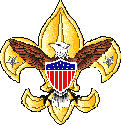| MERIT BADGES |
|
|
|
|
| Note: Eagle Required are in Italics |
"A"
American
Business
American Culture
American Heritage
American Labor
Animal Science
Archaeology
Archery
Architecture
Art
Astronomy
Athletics
Atomic Energy
Auto Mechanics
Aviation
"B"
Backpacking
Basketry
Bird Study
Bugling
"C"
Camping
Canoeing
Chemistry
Cinematography
Citizenship
Community*
Citizenship Nation*
Citizenship World*
Climbing
Coin Collecting
Collections
Communications*
Computers
Cooking
Crime Prevention
Cycling*
"D"
Dentistry
Disability Awareness
Dog Care
Drafting
"E"
Electricity
Electronics
Emergency
Preparedness**
Energy
Engineering
Entrepreneurship
Environmental
Science*
"F"
Family Life*
Farm Mechanics
Fingerprinting
Fire Safety
First Aid*
Fish & Wildlife Mgmt.
Fishing
Fly Fishing
Forestry
"G"
Gardening
Genealogy
Geology
Golf
Graphic Arts
"H"
Hiking
Home Repairs
Horsemanship
"I"
Indian Lore
Insect Studies
"J"
Journalism
"K"
"L"
Landscape Architecture
Law
Leatherwork
Lifesaving**
"M"
Mammal Study
Medicine
Metalwork
Model Design & Building
Motorboating
Music
"N"
Nature
"O"
Oceanography
Orienteering
"P"
Painting
Personal Fitness**
Personal Management*
Pets
Photography
Pioneering
Plant Science
Plumbing
Pottery
Public Health
Public Speaking
Pulp and Paper
"Q"
"R"
Radio
Railroading
Reading
Reptile & Amphibian Study
Rifle Shooting
Rowing
"S"
Safety
Salesmanship
Scholarship
Sculpture
Shotgun Shooting
Skating
Skiing
Small Boat Sailing
Soil & Water
Conservation
Space Exploration
Sports**
Stamp Collecting
Surveying
Swimming**
"T"
Textile
Theatre
Traffic Safety
Truck Transportation
"U"
"V"
Veterinary Medicine
"W"
Water Skiing
Weather
Whitewater
Wilderness Survival
Wood Carving
Woodwork
"X"
"Y"
"Z"
 Canoeing CanoeingRequirements 1998 |
- Show that you know first aid for injuries or illnesses that could occur while canoeing, including hypothermia, heatstroke, heat exhaustion, dehydration, sunburn, insect stings, tick bites, blisters, and hyperventilation.
- Do the following:
- Identify the conditions that must exist before performing CPR on a person. Explain how such conditions are recognized.
- Demonstrate proper technique for performing CPR using a training device approved by your counselor.
- Before doing the following requirements, successfully complete the BSA swimmer test. Jump feet first into water over your head in depth, swim 75 yards or 75 meters in a strong manner using one or more of the following strokes: sidestroke, breaststroke, trudgen, or crawl; then swim 25 yards or 25 meters using an easy resting backstroke. The 100 yards or 100 meters must be swum continuously and include at least one sharp turn. After completing the swim, rest by floating as motionless as possible.
- Do the following:
- Name an point out the major parts of a canoe and paddle.
- Know canoeing terminology.
- Explain and demonstrate canoe kneeling and sitting positions and the proper use for each position.
- Review and discuss BSA Safety Afloat, and demonstrate the proper fit and use of personal flotation devices (PFDs).
- Demonstrate how to load and secure equipment in a canoe.
- With a companion and using a properly equipped canoe:
- Properly carry, launch, and get into the bow of the canoe from dock or shore (both, if possible).
- Paddle 100 yards on one side only in the bow position using a single-blade paddle. Turn underway and return to shore or dock showing proper form and use of the bow or power stroke, diagonal draw, and quarter sweep. Repeat while paddling on the other side.
- While paddling on one side only in the bow position, demonstrate how to hold water and stop. Show proper form and use of the push away, pullover, reverse sweep, and backwater. Repeat while paddling on the other side.
- Change places with your companion while canoe is afloat.
- Paddle 100 yards on one side only in the stern position. Turn underway and return to shore or dock while maintaining course and giving proper signals to your companion. Show proper form and use of the stern (the J stroke). Repeat while paddling on the other side.
- While paddling on one side only in the stern position, demonstrate how to hold water and stop. Show proper form and the use of the push away, pullover, reverse sweep, and backstroke. Repeat while paddling on the other side.
- As bow paddler, make a proper landing and get out of the canoe while following directions from your companion. Repeat in the stern position giving directions to your companion.
- Store canoe properly.
- While on deep water with a companion, fully dressed
and wearing proper PFD:
- Jump safely out of the canoe. Get back in without capsizing.
- Capsize the canoe, get back in, secure all loose gear, and paddle the swamped canoe 25 yards. Go overboard from the swamped canoe and swim, tow or push the swamped canoe 50 feet.
- Empty the swamped canoe in shallow water.
- Demonstrate solo canoe handling:
- Launch from shore or pier (both, if possible).
- Using a single-blade paddle and paddling only on one side, demonstrate proper form and use of the forward stroke (J stroke), forward and reverse sweeps, backwater, stop, pullover, push away, inside and outside pivots, and sculling. Repeat while paddling on the other side.
- While paddling on one side only, paddle a 50-yard course making at least one turn underway and one reverse of direction. Repeat while paddling on the other side.
- Make a proper landing at dock or shore (both, if possible). Store canoe properly (with assistance, if needed).
- While alone in a canoe on deep water and wearing PFD, jump safely out of the canoe. Get back in without capsizing.
- With a companion in your canoe and while giving instructions to persons who have capsized a canoe in deep water, empty the swamped canoe over your own canoe and assist the persons in reboarding the emptied canoe.
- Discuss:
- General care and maintenance of canoeing equipment.
- How to rig a canoe for sailing.
- The difference between river (moving water) canoeing and lake (flatwater) canoeing.
|
||||||
Last Update May 15, 2023

.jpg)
